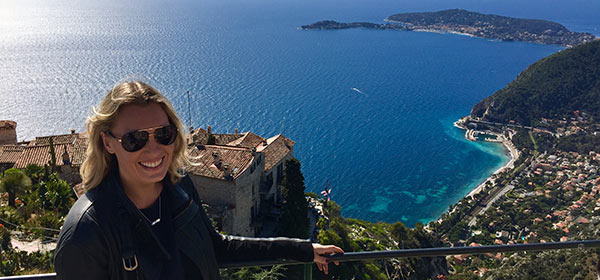While Monaco and Nice are synonymous with southern France, you’d be forgiven for not having heard of Eze before.
Perched high on a hill overlooking St Jean-Cap du Ferrat, Nice, and the sparkling sea below, Eze really is the jewel in the crown of southern France. Having never heard of it before January this year, two months later and just before midnight on a Friday night, I found myself sitting in the back of a car speeding around hairpin bends in pitch blackness. With no sense of surroundings, except the vague feeling that we were climbing higher and higher, the view that greeted us the next day was all the more astounding.
The heart of Eze is actually precariously concentrated on what can best be described as a rocky peak, some 1,400 feet about the Mediterranean Sea below. Formed from the ruins of a 12th-century castle, the village itself is a small labyrinth of alleyways. Most unusually, the commune of Eze is dominated by Chateau de la Chèvre d’Or, one of the world’s finest hotels. Impossible to miss, it is situated at the top of the village, and sprawls the majority of Eze, with its 30 suites dotted all around, many with front doors that open directly onto the main walkways. If you’re cheeky like us, the courtyards are well worth a peek for the jaw-dropping beautiful views, showcasing the series of terraces, swimming pools, gardens and sun decks that stagger their way towards the ocean, leaving a strong mental imprint of how the other half lives.
Perched at the top of Eze is the Jardin Exotique, featuring no less than 400 Mediterranean cacti, citrus trees and tropical plants. The perfect place to stroll around, the view from the top is the highest vantage point you’ll get and provides the perfect backdrop for photos. There are a number of places to sit and soak up the sun and scenery, but once you’ve seen enough cacti for the rest of your life, head back down to the church.
On the edge of Eze, there’s the church that was rebuilt between 1764 and 1778 by Italian architect, Antoine Spinelli. Intimate in nature, unlike many European churches that have been refurbished to within an inch of their lives, this one is charming in its faded glory, giving a real glimpse into how it must have been back when it was built. Adjacent to the church is the cemetery where World War I soldiers have been laid to rest.
It’s also possible to follow the steep olive strewn path, known as Chermin de la Mer, down to Eze-Sur-Mer on the Mediterranean where you’ll find beaches, water sports and al fresco dining; but we decided to forgo the hour and a half round trip in favour of jumping on a bus heading to Nice. Half an hour later, ensconced in an outdoors tapas place overlooking the beach, we were toasting our Aperol Spritz to a wise decision.
While Eze is well worth a visit and the perfect change of scenery from the tourist riddled rest of the Côte d’Azur, you don’t need more than a day there, unless, of course, you’re staying at the Chateau de la Chèvre d’Or, in which case you should probably never leave.
For a more affordable option, the three-star Hotel Hermitage Eze, is tucked away less than two kilometres above the main village. The charming Provençal style interiors are complemented by a swimming pool, cocktail bar and a sunny breakfast room. It may not offer the same grandeur that the Chateau de la Chèvre d’Or, but the homely atmosphere and friendly staff more than make up for that.
Related articles:
Five destinations best visited by ship
The hidden gems of France
Off the beaten path in Paris

